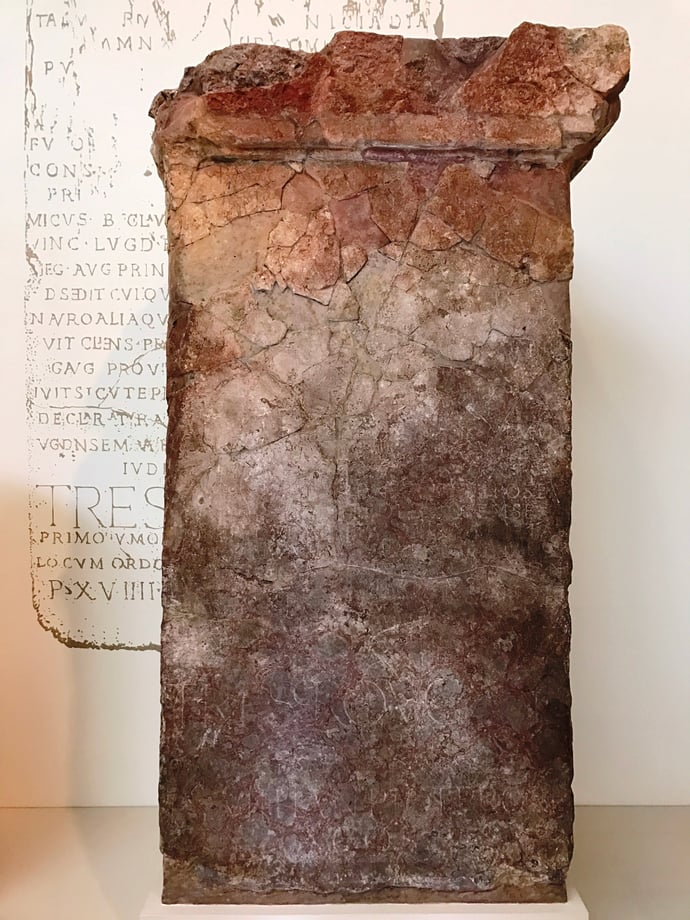
Marble of Thorigny
Cherbourg was taken the 27th of June 1944, when the harbor long reconstruction began. A few weeks later the heavy equipment finally will commence to be unloaded… This won’t slow down nor stop the artificial port of Utah beach to remain operational, on the contrary!
Utah Gooseberry harbor achieved the incredible engineering feat of unloading more than 730,000 tons of supplies, 225,000 vehicles and 840,000 American soldiers, all before the winter of 1944. In the late 60’s, an Italian company specializing in recycling steel scrapped everything off the coast of Utah beach, which is why you don't see anything standing there today.
What more is there to say? Ah yes, during the same period, the British Mulberry harbor (Gold beach) unloaded 540,000 tons of supplies. The reason you can still see some of the Phoenix containers there is because you can’t recycle concrete! That being said…
While Cherbourg harbor was cleared up of mines and explosives to render it operational as soon as possible, the Allied army was far from inactive: the Americans were already preparing a thrust towards the south with Carentan as a hinge, in order to descend the front line towards Lessay. They fleshed out the curtain of troops which stand guard between Carentan and Port-Bail.
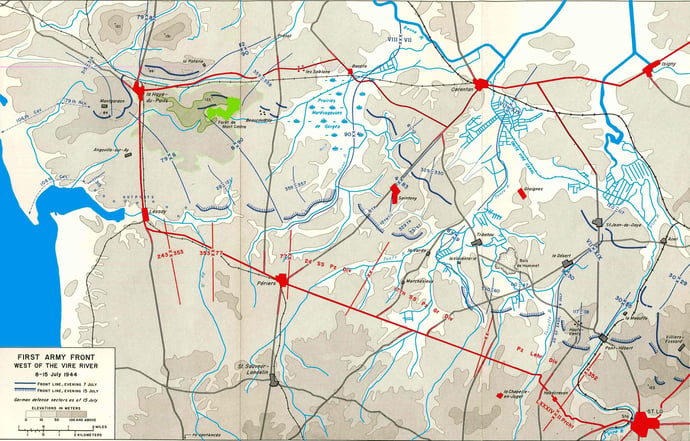
The Great Battle is coming… Saint-Lô in Ruins
In our previous blog “The Cotentin Peninsula: Liberated, But At What Cost?" we cited names of different communes of the Cotentin Peninsula whose population was under the line of fire the day after Dday and would live as such for three long weeks.
Try to imagine the state of mind of the population, who were separated from its liberators by just a few meters. The people lived through terrible hours, full of anguish, with alternating hope and fear.
Can we actually perceive today the meaning of these words: “During the counter-attacks, our troops took over some localities?” Then, the bullets whistled, the cannons thundered,and the bombs rained down with their horrible whistling but distinctive horrifying sound; civilians, including children, lived in the center of this carnage ... the houses collapsed and burnt, and shelters hastily dug in the garden and in the fields were of weak protection, often merely illusory.
These communes placed at the limit of the first stage of the taking of Cherbourg harbor, especially in the region of Carentan, were among the most affected of Normandy.
Gorges and Prétot (North West of Carentan) were seriously affected. Both lost half their houses; their churches were unusable for a long time, that of Gorges (from the end of the 13th century) in particular. Gorges, where resided a lord who participated in the Conquest of England in 1066 with William the Conqueror, is cited as one of the oldest parishes in the region.
So the second phase of operations in Normandy begam. The Allies were trying to "get some air" in the Carentan region, in the direction of Saint-Lô, and above all to clear and occupy as much coast as possible to the west.
On July 4, at 5:30 am, the Americans launched a strong attack in the direction of La Haye-du-Puits after a violent bombing of the German forces which lasted all night. At the western end, Port-Bail, whose old church and part of the town are destroyed, was overtaken by the events. Between Saint-Lô d’Ourville, whose church was seriously attacked, and Carentan, on a 40 kilometers front, the assailants fought in a veritable sea of mud: the line of marshes flooded by the Germans offered a serious, if not impassable, obstacle.
Denneville, Saint-Rémy-des-Landes, and Blanchelande en Neufmesnil fell. Farther to the east, Saint-Jores saw its church crumble under the shells; the village was totally destroyed: 120 houses uninhabitable, 475 victims out of 486 inhabitants.
1st anecdote: Blanchelande was a famous abbey of the Premonstratensians order, founded in 1155 by Richard, baron of La Haye-du-Puits.
2nd anecdote: Jules-Amédée Barbey d'Aurevilly (2 November 1808 – 23 April 1889) was a French novelist and short story writer wrote about Blanchelande in his book: L'Ensorcelée (The Bewitched, 1852; an episode of the royalist rising among the Norman peasants against the first republic). He specialized in mystery tales that explored hidden motivation and hinted at evil without being explicitly concerned with anything supernatural. He had a decisive influence on writers such as Auguste Villiers de l'Isle-Adam, Henry James and Marcel Proust.
La Haye-du-Puits, which was encircled, held another five days. It retained its ancient keep, at the top of which would no longer float the swastika flag, but the church was almost completely destroyed and the center of the charming little town was shaved. The train station of the city would appear in the communiqué on several occasions; it was situated on the neighboring municipality of Saint-Symphorien-le-Valois whose elegant bell tower disappeared with 63 houses: out of 334 inhabitants, 200 were once again homeless. Around La Haye-du-Puits, Coigny, Gerville, Neufmesnil and Vindefontaine, 30 to 55% of the population were victims of the battle.
1st anecdote: Viridorix had the reputation of defeating his Roman enemies by the cunning and magic of a mysterious beverage. As Viridorix ascended the land stuck between the territory of Unelles and the Bajocasses, along the present river La Vire, he had to fight against the Romans in an unfavorable ratio of one to ten. Viridorix was defeated near the Mont Castre and died in a fierce battle against the Roman armies.
The ratio of one to ten and the mysterious beverage gave ideas to Goscinny and Uderzo in the creation of their heroes Asterix and Obelix. The beverage would have survived; it bears the name of a territory on horseback between Unelles and Bajocasses: the Calvados!
2nd anecdote: After defensive action along the river Douve, the 90th infantry division attacked to clear the forest of the Mont-Castre (Hill 122), clearing it by the 11th of July, in spite of fierce resistance. In this action the Division suffered 5000 killed, wounded, or captured, one of the highest casualty rates suffered in WW II.
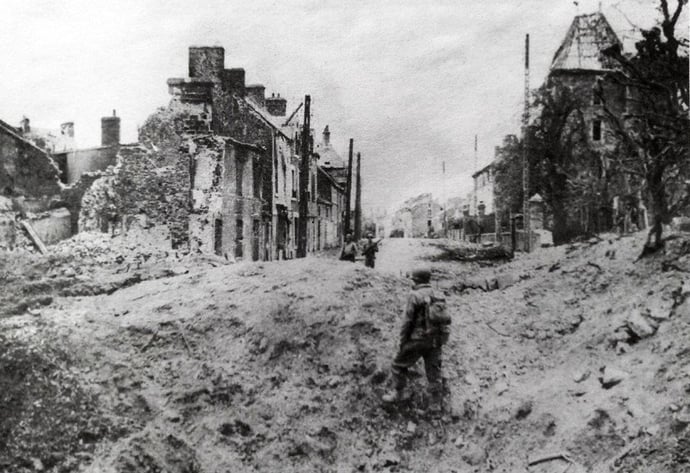
La Haye du Puits, rue du château
Progress continued toward Lessay: Montgardon was freed and ravaged, many were accounted dead, and one fought in the forest of Montgardon, which bordered a Roman camp believed to be that of Quintus Titurius Sabinus, lieutenant of Caesar, who fought the Gauls of Viridorix. But the progression was slow at all points of the 40 kilometers battle front. Why? Because the Germans resisted with determination in this marshy region, where it wass necessary to take trench by trench, shelter by shelter: a whole week would be necessary for the Americans to achieve an advance of only 1500 meters!
At the eastern end of the Cotentin front, on July 7th at dawn, the Vire was crossed in the area of Saint-Jean-de-Daye, between Carentan and Saint-Lô. It was a terrible blow to the enemy, for the junction was made with other detachments which had crossed the canal of Vire and Taute on a bridge built by the Engineers under the cover of a curtain of smoke. Thus Sainte-Jean-de-Daye was occupied without delay; part of the town was crushed, half of the inhabitants forced to look elsewhere for lodging. This penetration into the side of the enemy was very important, because it put in a precarious situation its defensive line in this sector.
In the neighboring commune of Saint-Fromond, the damages were considerable; in the aftermath of the month-long battle, 95% of the buildings were destroyed, including the church, a former abbey church with its magnificent 15th century carved wooden stalls. Almost all the people were affected (670 out of 718). They lived there, like many other villages in Normandy, in their stables or cellars. Ten people were killed— and about a dozen wounded— by some of the 45,000 shells that the Americans confessed to having shot on the unfortunate commune!
The township of Saint-Jean-de-Daye was among the most affected: Le Dézert, Le Mesnil-Véneron and Montmartin-en-Graignes were almost wiped out from the map, 95% destroyed; Les Champs-de-Losques, Le Hommet-d'Arthenay, Tribehou, Amigny and Le Mesnil-Angot, 20 to 55% of the homes are devastated.
The communiqué of July 10th announces, "The German line is breaking up in Normandy". In the Cotentin, the allied progression was now general, though still slow; on the same day, we learned of the fall of Mobecq (75% destroyed) west of Sainteny and Gorges in the center, of Cavigny (90% destroyed) at the eastern extremity of the front of the Manche department. In the latter sector, Pont-Hébert, threatened, was occupied the next day. In the middle of the village, the church was left in ruins; at the entrance and exit, dozens of houses were destroyed and the bridge over the Vire no longer existed. More than half of the population lost everything.
On entering Sainteny, the allies found a situation much more disastrous. Sainteny was one of those communes which remained for three weeks in the combat zone; it was a coquettish village of considerable importance, a large village of the Cotentin. It was left with the painful honor of being one of the most devastated. Of Sainteny, martyrized, nothing remains. The beautiful church of the XIVth century was razed, as well as all of the dwellings.
On the 6th of June, the German elite troops arrived in the commune, and it was easy to guess that Sainteny would be on the front line of resistance of the allies advance. From June 8th to July 20th, shells and bombs continuously rained down on the agglomeration and on the various villages changing hands 5 times; before retreating, the Germans burned what was still standing; and what had been spared or resisted to the flames was annihilated by the “Boche” artillery in the days which followed the liberation of Sainteny: church, castle, farms, village, everything was reduced to ashes or ruins! The cemetery itself was devastated. Out of 245 houses, 151 disappeared, not one of the remaining 94 is still intact, and the population, upon their return, had to settle in the least damaged barns and stables; 2000 head of cattle perished and all agricultural equipment disappeared. The land mines that infested the fields have, after the war, made new victims.
1st anecdote: Jean Sainteny (he wasn’t born there…) son-in-law of the Prime Minister Albert Sarraut, was an insurance broker. He was in charge of the Normandy sector for the French resistance under the pseudonym "Dragoon". He was captured by the Gestapo but succeeded in escaping and took part in organizing the Normandy landings, passing to General George Patton the information that allowed the Allies to reach Paris.
2nd anecdote: On the 4th of July, the 83rd Infantry Division left Carentan and moved south toward Sainteny, a short march of about four miles that quickly turned into a six-day battle claiming over 1,400 casualties in the first 24 hours. By the time Sainteny was taken on July 10th that number increased to 3,264 casualties.
The desolate and sinister vision of the ruins was everywhere; one could go from Sainteny to Méautis, from Sainteny to Raids, to Auxais, to Saint-André-de-Bohon without finding a single inhabited house.
In the country, everything was collapsed or burned, the abrasions shredded by the grapeshot, the roads and the paths smashed down by bombs and shells. Officers admitted later that they have rarely encountered such a set of destructions and ruins.
Sainteny, the most affected commune of the Carentan canton seems only a memory.
Let's stop for a moment to discuss this particularly affected area on the neighboring communes of Auxais, Saint-Georges-de-Bohon, of Raids also placed on the front line of the German resistance.
In June and July, Auxais was occupied and evacuated on several occasions as bitter fighting took place on its territory; its old church - an old abbey church - its castle, which dated from the 12th century, were in ruins; the cemetery was shaken; out of 65 houses, 30 have disappeared and the rest were practically uninhabitable; the 250 inhabitants are all victims, with 126 ultimately losing their lives. Saint-Georges-de-Bohon (80% of victims) also lost its old abbey church (part of it dating back to the 11th century) and almost all of its dwellings. It was the homeland of Onfroy de Bohon, who took part in the conquest of England. There, as in many other villages, the Germans obliged the inhabitants to carry in their carriages: soldiers, ammunition, dead and wounded, in the midst of fighting and grape-shot, and in total defiance of all international conventions.
Anecdote: The family of Bohun (or Bohon) is an Anglo-Norman baronial family from Saint-Georges-de-Bohon in the department of the Manche. After the Norman conquest of England, members of this family settled and prospered there, holding various royal offices. They finally acquired the title of Earl of Hereford in 1200, then that of Earl of Essex in 1239, thanks to their kinship with the Mandeville. The male line stopped at the height of its power in 1373, with the marriage of the two daughters of Humphrey of Bohun, 7th Earl of Hereford to two members of the British royal family, one being Henry IV (15 April 1367 - 20 March 1413), also known as Henry of Bolingbroke.
The village Raids suffered little less than its neighbors: the village, with its church, has been wiped out…
In Méautis, one third were homeless and 29 dead, including a dozen executed by a firing squad; at Saint-André-de-Bohon, a quarter of the inhabitants no longer have a home.
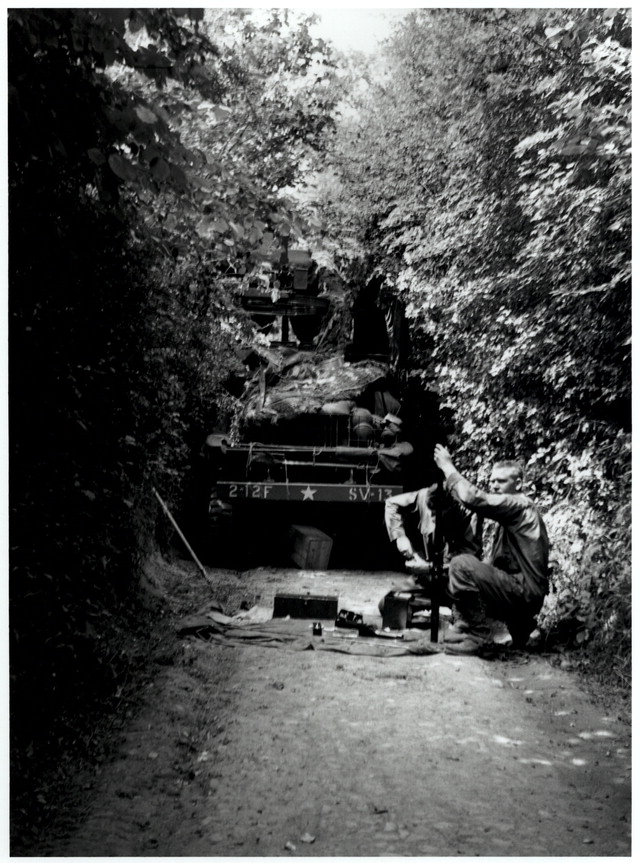
Battle of the hedgerows
The struggle everywhere was severe and fierce; but the Allies continued to gain ground. On July 12th, the Saint-Lô region was the most important target: the Americans held the hills that dominated the city, especially by the capture of La Meauffe, of which 600 of the 650 inhabitants were affected, and Saint-Pierre-de-Semilly where my parents-in-law now live. The latter is located to the east of Saint-Lô: it is rich in historical memories. Vestiges of a castle of the Xth century, a church of the XIth, a charming manor of the XVIth, since 1330 owned by the Mathan family. Today, it's a peaceful setting where you can go on a beautiful walk in the country.
Anecdote: The 11th and 12th July 1944, the village La Meauffe was attacked by the American 35th Infantry Division, while defended by the German 352nd Infantry Division (the infamous division who caused so many casualties on Omaha beach) and units of the 266th Infantry Division. The fighting, violent, started the 11th and ended the 12th at the cost of the lives of 19 US soldiers, wounding 170, with 25 missing. The road D54, leading to La Meauffe was renamed the “Death Valley Road” by the US soldiers
The castle, remarkable for its varied architecture, was transformed into a fortress by the Germans during the six weeks of hard fighting inthe theater of Saint-Pierre-de-Semilly. Despite the formal order of Carl-Heinrich von Stülpnagel, it was plundered by the soldiers of Hitler, who devastated the part reserved for historical and artistic memories of the greatest value; during the battle, it was almost entirely destroyed. The old church did not have a more favorable fate or the borough either!
On the grounds around Saint-Pierre-de-Semilly, there were 214 bomb craters and 15,000 shells impact; additionally, the Germans had dug 12,000 individual trenches and cut down 5200 apple trees! When you walk in the countryside you can still visualize some foxholes.
1st anecdote: Saint-Pierre-de Semilly, after having been the center of a Roman town, was once a fortified place with streets, squares, and at least three doors pierced in its enclosure; its old castle was inhabited by the Dukes of Normandy, Kings of England. Henri I, Henry II and Richard I known as Richard Coeur de Lion signed there numerous charters.
2nd anecdote: General Carl-Heinrich von Stülpnagel was a member of the July 20 Plot to assassinate Adolf Hitler, being in charge of conspirators' actions in France. After the failure of the plot, he was recalled to Berlin and attempted to commit suicide en route, but failed. Tried on 30 August 1944, he was convicted of treason and executed on the same day
Not one of the inhabitants of La Barre-de-Semill's home was spared. Saint-André-de-l'Épine is now no more than a memory.
In the same area is Le Mesnil-Rouxelin, another martyrdom commune that has lost 80 houses out of 81! Only one habitable house remained! Le Mesnil-Rouxelin lived through thirty-one days of hell; the fields are mined, 80% of the herd perished, 90% of the apple trees were cut down, and the small agglomeration no longer existed. On the 18th of June, the Americans were just 200 meters from the bell tower, the inhabitants hoped for a near rescue. But the Boche resisted and plundered: he looted the houses to build, consolidate and furnish the trenches in which he was living, ready for battle. Anything went; doors, windows, barriers, and roofs made of sheet metal, Norman wardrobes and all furniture panels, clothes, linen, bedding, dishes ... Powerless, the inhabitants witnessed this carnage under a rain of shells.
Saint-Georges-d'Elle changed hands five times and suffered appalling devastation.
Anecdote: You can see on the Normandy American Cemetery of Colleville sur Mer missing wall a Bronze Rosette next to the name of Sergeant John Simonetti who was M.I.A. at Saint-Georges-d’Elle. The 26-year-old was fighting with the Army’s 2nd Infantry Division on June 16, 1944, trying to roust German troops from the French village of Saint-Georges-d’Elle. The sergeant was firing a grenade launcher at a machine gun nest when he was killed by a single bullet from a German sniper. His unit eventually retreated and Simonetti’s body was gone when they took the village three days later. His first burial was in a two-foot deep trench. In 2009 he was found, identified and now rest at the Arlington cemetery.
Around Saint-Lô, desolation reigned. Agneaux, Baudre, La Luzerne, Notre-Dame-d'Elle, 80% of the inhabitants lost everything; Gourfaleur, Sainte-Suzanne-sur-Vire, Sainte-Croix-de-Saint-Lô, Saint-Germain-d'Elle, 60% were homeless; Rampan, Saint-Thomas-de-Saint-Lô villages, 30 to 40% were destroyed.
In the Cotentin, the three main objectives of the Americans were, for the moment, Lessay, Périers and Saint-Lô
In the first two sectors, Périers and Lessay, the floods made the advance difficult: the basin of the small river Ay was completely flooded; the Germans demolished all the bridges within a radius of several miles around Lessay; towards Périers, the Americans tried to bypass the submerged part by taking Gonfreville and Saint-Germain-sur-Sèves. But Périers, an important road node, was well defended; it would be less so, however, than Saint-Lô, whose suburbs were attained, and whose importance was much greater.
And the communiqué suggested there was a fierce resistance on the heights north of the Saint-Lô - Coutances road. In this region, the Germans fortified the castles, the churches, and houses; the Americans were not mistaken in their predictions: the communes which occupy or surround these heights would ravaged to the point of being classified at the top of the martyred villages of the department!
On July 16th, Lessay was overrunned to the east and west, and then occupied after close hand-to-hand combat, each house having been practically transformed into a small fort with the intention of preventing American advancing on the west coast of the Cotentin.
Alas, Lessay paid dearly for its liberation and the honor of having been the true starting point of the American offensive, which on the 27th of July began with a breakthrough of the enemy lines (Operation Cobra) and was to lead the Allies in a single leap, to Paris and the border of Germany.
What had not been destroyed by the Hundred Years' War, the burning of 1356, or the wars of Religion was annihilated in a few moments in the century of civilization! In a deluge of iron and fire, the church of Lessay, the old church of the abbey, disappeared and a whole part of the town with it: the town hall, the castle, 80 houses are destroyed, others are uninhabitable; the WWI monument disappeared in the turmoil; 1/3rd of the population lost their homes.
1st anecdote: Lessay owed its reputation to its ancient Benedictine abbey, one of the most authentic and best preserved monuments of Romanesque art and which was to celebrate its ninth centenary anniversary. It was founded in 1056 by Richard de La Haye-du-Puits; the charter of foundation was signed by William the Conqueror and the most illustrious persons of Normandy by the most powerful Norman barons. Later a Papal bull had consecrated the importance of the famous monastery.
Note: Papal bull is a formal proclamation issued by the pope usually written in antiquated characters and sealed with a leaden bulla
2nd anecdote: The Sainte Croix fair of Lessay is a trade fair established in the 11th century to develop commercial activity in the village. Today for three days 42 acres (170,000 m2) of Lessay is transformed into a huge marketplace, attracting over 400,000 visitors. The fair offers demonstrations of old and new trades, thousands of stalls selling a range of products from household equipment to animals, food, cars and garden and agricultural tools
In the surrounding countryside, the damage is no less. Vesly, whose nave of the church will remind you of the room of the Knights at the Mont Saint Michel with elegant monolithic columns, is destroyed: 65 of its 69 inhabitants lost their homes. In Saint-Patrice-de-Claids, 85% were homeless, and finally, in Angoville-sur-Ay and Millières, 35% of houses were destroyed.
While the American army liberated Lessay, some of its elements, at the other extremity of the front of the Cotentin, entered by way of the East and the South into Saint-Lô, where they soon engaged in terrible street fighting.
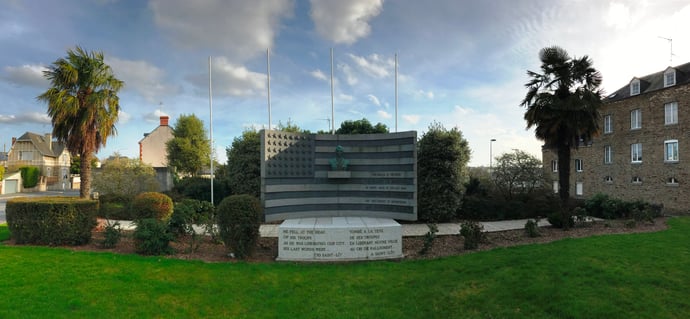
Monument of the Major of Saint-Lô
The Americans in Saint-Lô? That's saying a lot; in what used to be Saint-Lô, would be more appropriate!
The battle for Saint-Lô was at that time the hardest of the Normandy campaign. It lasted six days. An American war correspondent was able to write: "Gains can only be measured by counting fields and groves of trees ... The damage around the city testifies of the violence of the battle ... Corpses litter the fields and fill the ditches ... ".
Saint-Lô actually ceased to exist June 6th: a terrible aerial bombardment made it, in a few moments, the capital of the ruins!
The first bombs had fallen in the afternoon of the 6th, around 4h30 pm on the train station. A few hours later, at 8 pm, 14 flying fortresses flew over the city and launched their bombs at random: various neighborhoods (center and south) were hit. The exodus which had begun as the first attack intensified, but already many dead and wounded lay in the rubbles; those who flee carried only the clothes that they have on their backs.
And in the night, the flying fortress flew back to complete their work of destruction; at midnight, 3 am, 5 am, planes continued by hundreds, causing destruction and death on the unfortunate city. At dawn, Saint-Lô was no more than an immense brazier.
A witness tells that during the midnight bombardment, for twenty long consecutive minutes, the bombs fell at the rate of one per second!
A most poignant spectacle awaited the first rescuers at the Saint-Lô prison, in which the German guards had locked up the hostages and terrorist due to be executed by firing squad. Dozens of corpses were to be found, as well as many, many bones.
What was once a coquettish, flourishing, welcoming city, a night of hell had turned into a veritable desert, a heap of smoking rubbish. In the enormous brazier, beneath the heaps of pebbles, twisted scrap of metal laid alas, innumerable and innocent victims. Vision of horror and terror...
More than 500 corpses were removed from the rubble, search for others continue, the fear being there will be as much, if not more, found!
Saint-Lô, the capital of the Manche department, was a picturesque city: at each entrance to the city, panels invited the traveler to stop there to admire its cathedral and its splendid panorama of the Vire valley, the old ramparts and the postern.
The panorama remains ... lamentable with all the ruins that spread out at your feet. But, like the city, the cathedral has almost disappeared: Notre-Dame de Saint-Lô is no more than a ruin; all that remain are some walls and the base of one of the two elegant towers that rose to 80 meters in the sky.
This magnificent church, whose admiration from the Cotentin citizens made it into a cathedral, was an ancient collegiate church, a historical monument of the 14th, 15th and 16th centuries. The most notable features were the beautiful facade, the double ambulatory choir, the stained-glass windows and the stalls. A rain of stones submerged the altar and the venerated statue of Notre-Dame du Pilier.
In the midst of these ruins, dominating them, the great Christ of the transept remains alone, as if suspended in heaven ... afflicted, weeping over so much misfortune, over this appalling martyrdom, over the infinite misery of so many of his children! He remains there, this Christ, as a supreme hope.
The second parish of the city, Sainte-Croix church, is partly collapsed: the ancient Maison-Dieu, with its remarkable carved wooden facade, has disappeared; the Hotel de la Prefecture, the elegant town hall, the departmental archives, the rich museum, the hospice, the Bon-Sauveur, the train station, etc… all ancient and modern monuments are annihilated.
The famous marble of Thorigny once more escaped the disaster. However, severe blows of pickaxes received during the work of clearing up the rubbles after the war have somewhat deteriorated it.
1st anecdote: The marble of Thorigny is one of the oldest monuments of ancient Gaul, the most important monument of the country and one of the most remarkable of France. In the third century AD, it served to support a statue in the village of Vieux (Calvados) in honor of Titus Sennius Sollemnis. It is exposed in the Saint-Lô museum of Art.
2nd ane



















